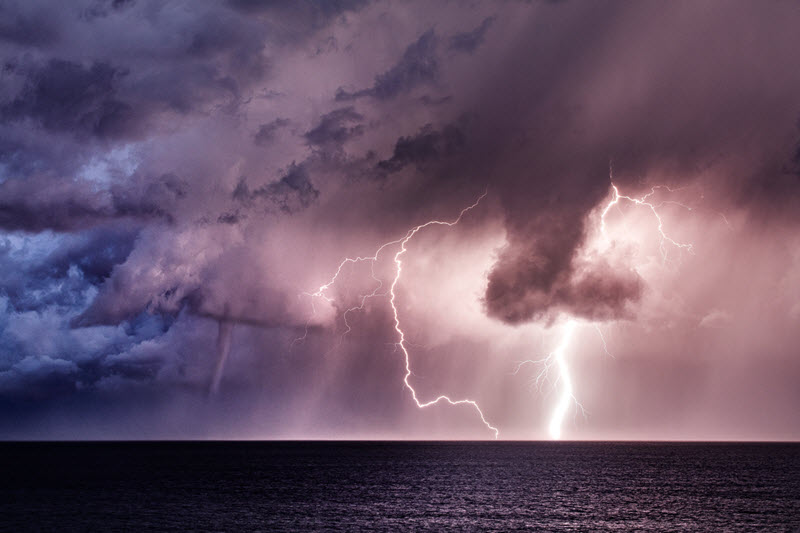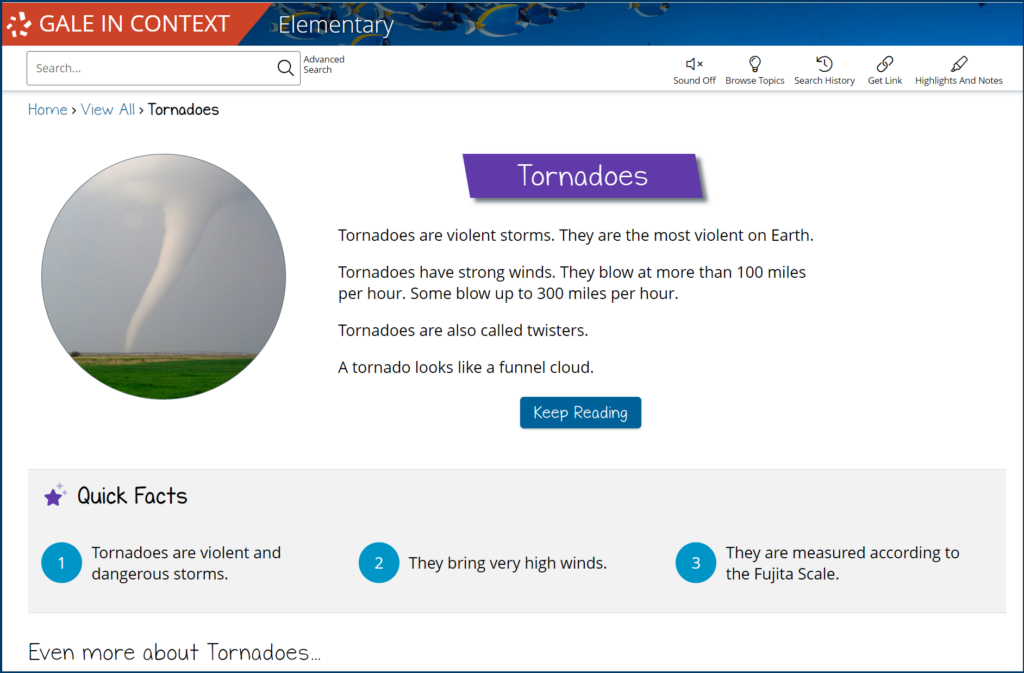| By Gale Staff |
The sky darkens to the color of a healing bruise, a sickly green that makes the hairs on your neck stand up. The air feels heavy, charged with electric anticipation, creating an eerie feeling of calm that settles like a damp blanket. Suddenly, as a distant rumble grows louder, the haunting wail of a siren slices through the stillness. A twisting column of air descends, whipping the world into a chaotic miasma of wind studded with debris.
Tornadoes are one of nature’s most violent displays, able to capture our imagination with their raw, unbridled force. In 1996, director Jan de Bont brought the nightmare of this natural disaster to the big screen with Twister. Now, Lee Isaac Chung is again tapping into those primal fears with Twisters, a sequel set for release on July 19, 2024. Educators can capitalize on the renewed interest in extreme weather sparked by Twisters to encourage elementary students to explore their fascination with extreme weather.
Get a jump start on lesson planning with the curated collections of multimedia resources available on Gale In Context: Elementary’s tornado portal, and the lesson ideas below.
For Lower Elementary: Introduction to Tornadoes
When introducing lower elementary students to the concept of tornadoes, the goal is to spark curiosity and wonder without lingering on the more frightening aspects. Teachers can focus on the basic mechanics of how tornadoes form, using simple language and engaging visuals. This emphasis on the phenomena behind tornados can foster a fascination for meteorology while ensuring that the content remains accessible and non-threatening.
To get started, use student’s existing knowledge about thunderstorms, something they have likely experienced, to explain how they can evolve into tornadoes when the conditions are right. Gale In Context: Elementary supports educators in this mission by providing a variety of colorful images, short videos, and reference articles that make these explanations both fascinating and informative for young learners.
Ask students to share what a thunderstorm is like, drawing particular attention to the strong winds that often accompany them. From there, explain that tornados are similar to thunderstorms, but the wind from the storm makes a funnel of spinning air that rotates very quickly, in rare cases at more than 300 miles per hour.
These fast-moving winds form when warm, moist air from the Gulf of Mexico meets cold, dry air from Canada and hot, dry air from the southwest. Rather than mixing, these air masses crash into each other, forcing the warmer, lighter air to rise above the cooler, denser air. This upward movement, combined with the clashing air masses, creates the powerful, swirling winds of a tornado.
Because they need such specific conditions to form, these storms are most likely to form in an area of the central United States called Tornado Alley, which stretches east from central Kansas to western Ohio and runs lengthwise from northern Iowa to central Texas.
Activity Idea: Tornado in a Bottle
Tornado in a Bottle is a classic example. It uses inexpensive household objects like glitter, dish soap, food coloring, and an empty soda bottle to let young learners observe tornado formation in action. Encourage students to practice their scientific observation skills, drawing what they see happening in the bottle after giving it a few rotations.
For Upper Elementary: The Impact of Tornados
As students progress into upper elementary, their capacity for participating in deeper discussions about tornadoes’ human impact grows. As you bolster their basic understanding of tornadoes with more complex meteorological concepts, incorporate outside media like books and documentaries to foster a sense of empathy for those whose lives have been reshaped by these formidable natural forces. This dual approach of blending hard science with human experience is a natural way to incorporate social-emotional learning.
Gale In Context: Elementary provides a student-safe research space where learners can dig into content about real storms’ destructive power. Start with Gale’s “Most Destructive Tornadoes” graphic, which covers tornadoes holding the records for the most expensive, windiest, widest, and more. Topping the list is the Tri-State Tornado of 1925, the deadliest tornado in U.S. history. With winds estimated at more than 300 miles per hour, this storm wreaked havoc along a 219-mile path through Missouri, Illinois, and Indiana. In its wake, the storm left more than 2,000 injured and 695 dead.
Activity Idea: A Real-Life Night of the Twisters
Ivy Ruckman’s Night of the Twisters is an award-winning, semi-fictional account of the night in 1980 when seven tornados devastated the town of Grand Island, Nebraska. Told from the perspective of 12-year-old Danny, it follows his harrowing journey of keeping his infant brother safe after their home is destroyed. The boys face continued adversity when the supercell remains stationary over the town for three hours while Danny desperately searches for his parents.
After finishing the novel, learners can practice perspective-taking by using the information gathered from Gale’s “Most Destructive Tornadoes” to write their own descriptive narratives, imagining personal experiences during storms similar to Danny’s.
You can set your classes up for success by working together to identify passages from the novel that made readers feel anxious, relieved, scared, etc. Follow that up with a discussion about what made these passages so compelling and the importance of having a relatable character tell the story.
For All Grades: Review Tornado Safety
Regardless of the grade you teach, consider spending some time reviewing tornado safety, including what a tornado siren sounds like and the steps students should take if they hear one.
NOAA’s official list of basic tornado safety rules summarizes these concepts into just a few bullet points, including:
- If you’re outdoors, go indoors. If you can’t go indoors, get down as low as you can and cover your head with your hands.
- If you’re in a mobile home, move to a stronger nearby building.
- The safest place in a building is underground, in a basement, in a small interior room, or under a sturdy structure.
- If there is no basement, go to an interior room, such as a closet or bathroom on the lowest floor. Use blankets, pillows, or cushions to shield your body and stay away from windows.
- If you are in a public building, including a school, listen closely to the people who work there to figure out where you should go.
Activity Idea:
Putting school tornado drills in the context of a larger in-class discussion on extreme weather helps give purpose to the practices. Bring your class to their designated drill location and practice the safety position—crouching low to the ground while covering their heads and necks with their arms—until a grown-up tells them that it’s safe to move.
Explain the difference between a tornado watch (conditions are favorable for tornado formation) and a tornado warning (a tornado has been sighted nearby or on the weather radar). Learning these distinctions will help them make split-second decisions based on the situation. During a watch, it is important to stay informed and prepare to act quickly if the situation escalates. When there’s a warning, a siren will sound indicating to move directly to a safe location.
Making Scientific Exploration Safer for Elementary Classrooms
Understanding the natural world, including devastating phenomena like tornadoes, fosters curiosity and encourages critical thinking. However, we must protect little learners from the disturbing details that students aren’t yet developmentally or emotionally ready to process.
Gale In Context: Elementary empowers teachers to meet their learners where they are with age-appropriate, engaging content that tackles tough topics. Because our platform is self-contained, there’s no risk of your classes accessing general search engine results. Instead, you can rest assured that students are working with vetted materials that accurately address scientific concepts in the language and formats elementary schoolers require.
Interested in learning more about the positive impact Gale can have in your science class? Speak with a local sales representative to request a trial to Gale In Context: Elementary.


